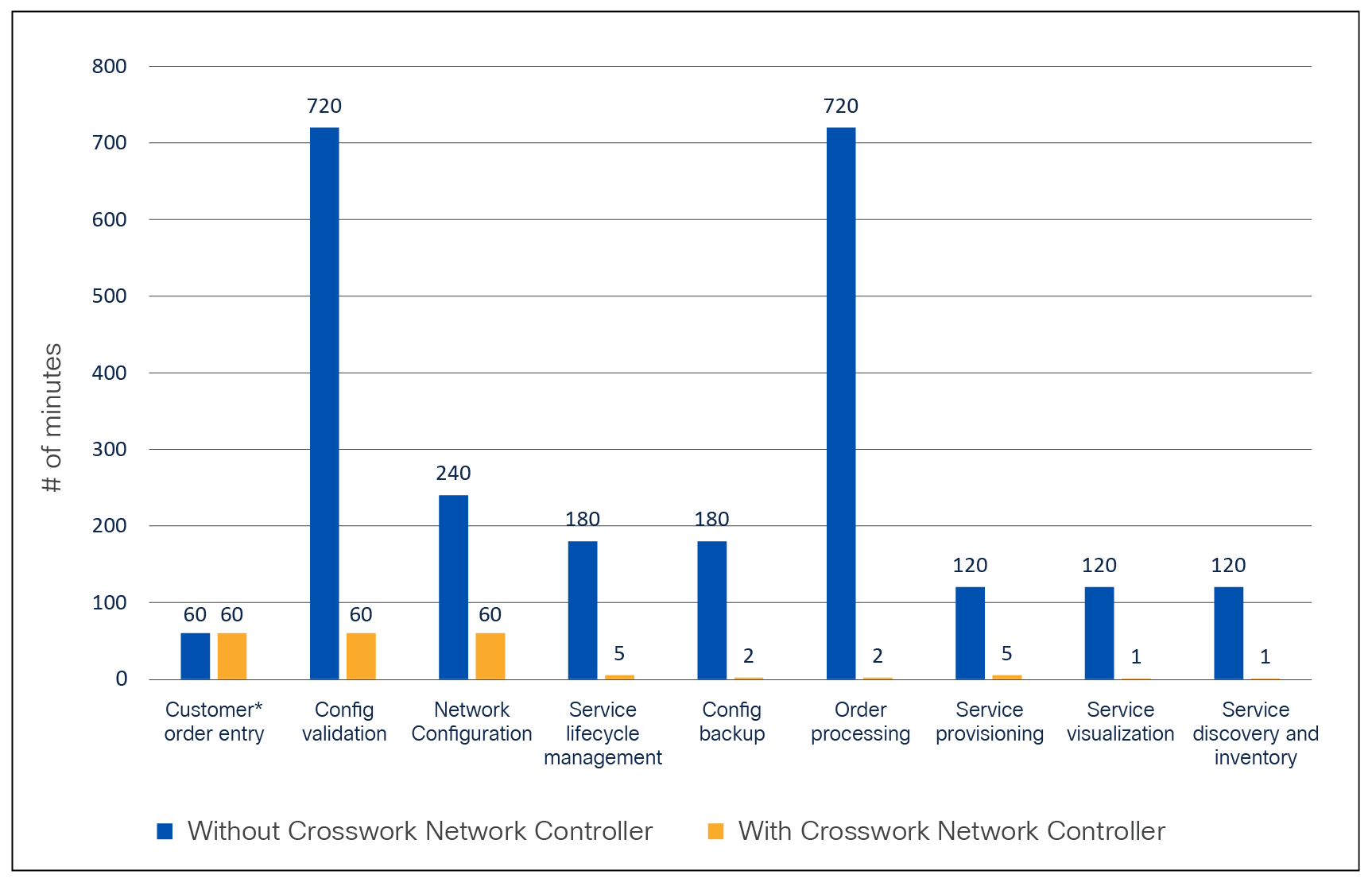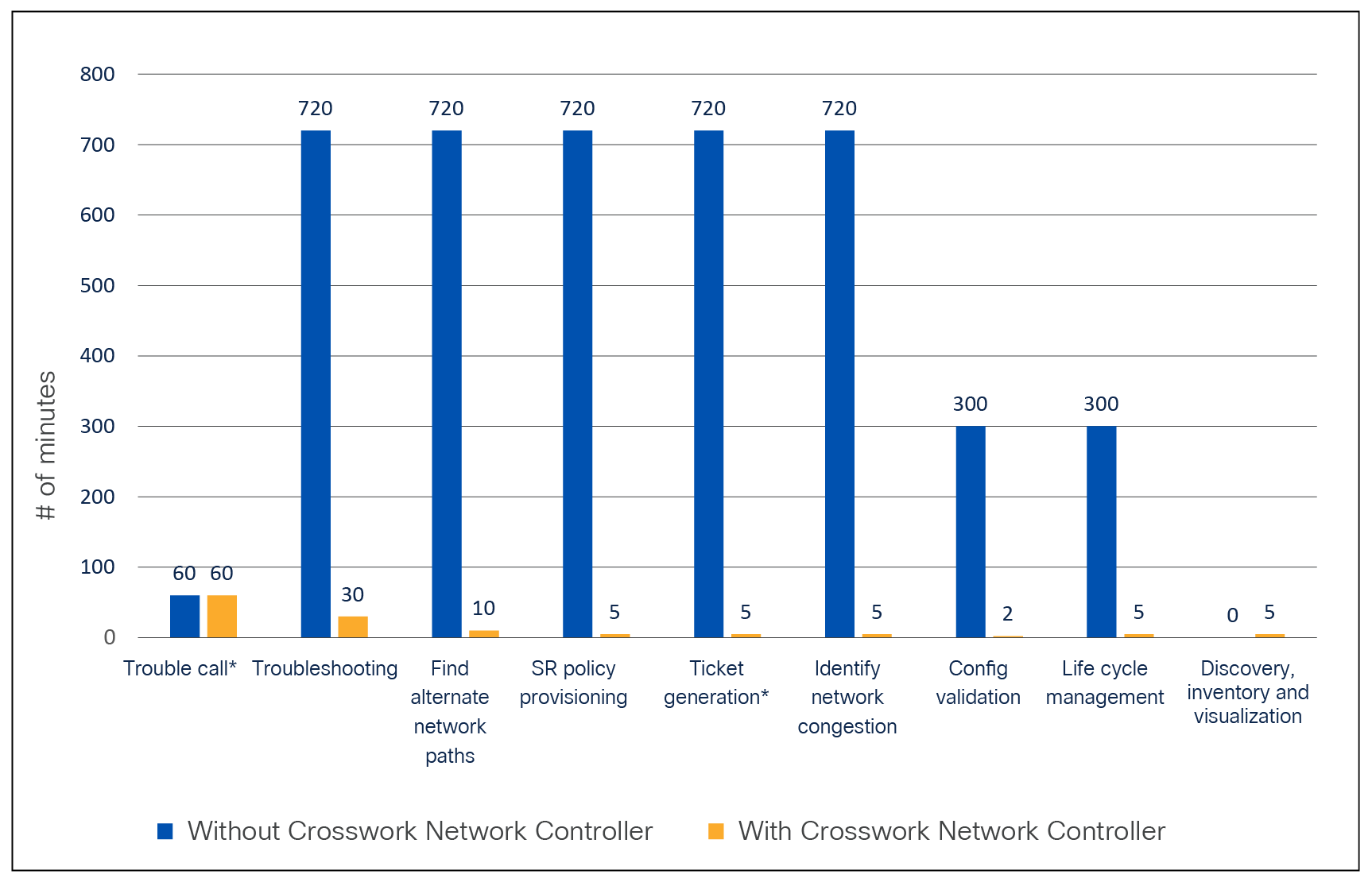Validated Ways to Cut Costs, Increase Revenue, and Meet SLAs with Crosswork White Paper
Available Languages
Bias-Free Language
The documentation set for this product strives to use bias-free language. For the purposes of this documentation set, bias-free is defined as language that does not imply discrimination based on age, disability, gender, racial identity, ethnic identity, sexual orientation, socioeconomic status, and intersectionality. Exceptions may be present in the documentation due to language that is hardcoded in the user interfaces of the product software, language used based on RFP documentation, or language that is used by a referenced third-party product. Learn more about how Cisco is using Inclusive Language.
- US/Canada 800-553-2447
- Worldwide Support Phone Numbers
- All Tools
 Feedback
Feedback
Your SDN controller affects profitability and SLAs
This white paper explains five validated ways Cisco Crosswork® Network Controller, a key component of our Crosswork Network Automation Platform, can pay for itself, based on an extensive study conducted by Cisco’s development team. We can use the metrics and results shown here as the basis of a personalized analysis for your organization.
How much will it cost to manage your IP transport network?
Management time and equipment costs for your network can vary widely. The difference is whether you have the right tools. An advanced software-defined networking (SDN) controller can significantly simplify management and operations, lower expenses, and also help you monetize the network:
● Service provisioning. With fragmented tools, provisioning can take weeks. Network operators need to individually configure products from multiple vendors, each with its own management application. Validating that the service works as expected takes still longer. With the right SDN controller you can get the job done in minutes.
● Service assurance. Missed Service-Level Agreements (SLAs) lead to fines, customer churn, and reputational damage. How will you make sure you’re consistently meeting SLA targets? An advanced SDN controller automatically selects the optimum path for each traffic flow depending on the SLA.
● Capital expense reduction. Traffic volume fluctuates, and overprovisioning to handle peak volume along each path is costly. The right SDN controller can optimize your existing bandwidth by rerouting traffic from congested paths to paths with available capacity.
● New revenue streams. Service providers are under constant pressure to increase revenue streams. You can monetize your network by introducing tiered pricing, charging more for higher SLAs. The right SDN controller will help you guarantee differentiated services and meet SLAs.
● Holistic view of the network. Managing multivendor networks using multiple vendor management applications is time-consuming. Administrators need to monitor and reconcile reports from multiple systems. Without a holistic view of network and traffic flows, it’s difficult to optimize the network for current conditions. An advanced SDN network controller can bring together information from multiple domains onto a single interface, putting you in control of the entire network and its services.
Introduce new services faster, manage them with far less staff time, and consistently meet SLA targets with the Cisco Crosswork Network Controller. Network Controller provides end-to-end SDN automation across multivendor IP transport networks. A single pane of glass gives you visibility and insights across the entire network. Automated service provisioning and network optimization helps you accelerate revenue, deliver quality services, and take full advantage of existing network capacity.
Here are five ways Network Controller provides Return On Investment (ROI).
1. Reduce operational expense by automating service delivery
In our studies, the Crosswork Network Controller cut service management time by 90%—from 40 hours to 4. Managing services in less time lowers operational expense and lets the same-size staff support more services. As shown in Figure 1, the biggest time savings for provisioning a VPN overlay or segment routing underlay service are:
● 11 hours saved on order processing—from 720 minutes to 60
● 3 hours saved on configuration validation—from 240 minutes to 60
● Nearly 3 hours saved on service provisioning—from 180 minutes to 5
● Nearly 3 hours saved on network configuration—from 180 minutes to 2
These savings alone amount to 20 hours per service. The more services you provision, the greater the savings.

Sample before and after comparison: Service management time was cut by 90%
2. Automate network optimization to meet SLAs consistently, with less effort
Visualize network performance anywhere on your multivendor SDN from a single interface. Quickly spot emerging performance issues and resolve them sooner by automatically identifying a faster network path. In our studies we saved:
● Nearly 12 hours identifying network congestion—from 720 minutes to 5
● Nearly 12 hours identifying a faster network path—from 720 minutes to 5
● Nearly 12 hours validating the new configuration—from 720 minutes to 5
● Nearly 5 hours provisioning a segment routing policy—from 300 minutes to 2
The Cisco Crosswork Network Controller saves more time by eliminating manual data-entry errors, showing accurate inventory information in one place, and helping you avoid penalties from missed SLAs.

Sample before and after comparison: Time to detect and resolve issues dropped from 80 hours to 2
3. Accelerate revenue realization
Automating service provisioning can help you deploy days or weeks sooner, accelerating revenue. Say a fleet manager needs low-latency connectivity between its on-vehicle Internet of Things (IoT) devices and the cloud, for near-real-time analytics. With the Cisco Crosswork Network Controller, configuration is as simple as selecting latency and other variables from a drop-down menu. The same goes for a healthcare system that needs guaranteed bandwidth for its remote medical-imaging specialists.
In our study, Network Controller reduced the time to provision a new service from 40 hours to 4. The more services, the bigger the potential gains:
● 1 service: Save 36 hours, accelerating revenue by 4.5 days
● 10 services: Save 360 hours, accelerating revenue by 45 days
● 500 services: Save 18,000 hours, accelerating revenue by 450 days (14 months)
To calculate incremental revenue from faster provisioning, multiply the number of days saved by daily revenue.
4. Increase revenue by introducing tiered pricing
Some service provider customers will pay a 25% to 50% premium for lower latency, especially for cloud-to-cloud communications. Others, such as public safety organizations, will pay a premium for guaranteed bandwidth during critical periods. The Crosswork Network Controller helps you introduce tiered pricing—for example, Silver, Gold, and Platinum—with less effort. It also helps you meet each tier’s SLAs by automatically choosing a new network path if performance dips below a threshold you set.
To estimate the new revenue potential from tiered pricing, multiply the premium by the projected number of customers. For example, suppose you’re currently billing for 10,000 connections at $50/month and estimate that customers would pay a 25% premium for lower latency for one-fifth of those connections. Incremental revenue would be:
(25% x $50/month) x (20% x 10,000) = $25,000 incremental revenue per month
In most of today’s Multiprotocol Label Switching (MPLS) networks, each router needs to create forwarding instructions and synchronize its state with all other routers along the path. Maintaining state information requires powerful routers and also increases latency.
The Cisco Crosswork Network Controller can cut equipment and power costs with a smart traffic-engineering technique called segment routing. The source router creates forwarding instructions, inserting an ordered list of segments into the packet header. Other routers simply follow the instructions. Segment routing cuts equipment costs by eliminating resource-heavy MPLS signaling protocols and reducing the number of routers needed. A study by ACG Research shows how the Crosswork Network Controller and Cisco® 5G routers help to reduce capital expense by 60%.
Contact your local Cisco account manager.
Learn more about the Cisco Crosswork Network Controller.
Learn more about Cisco Crosswork Network Automation.
 Feedback
Feedback